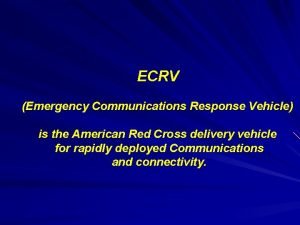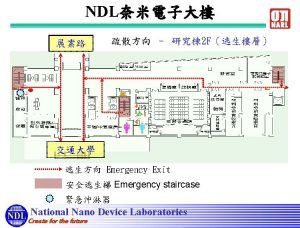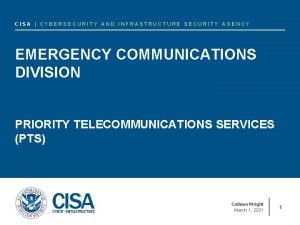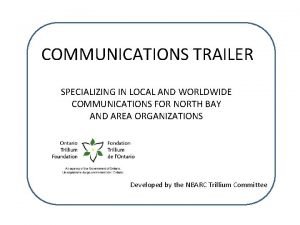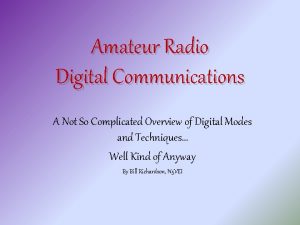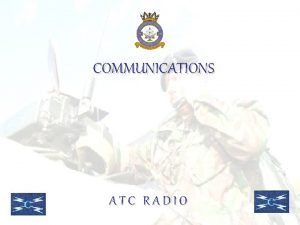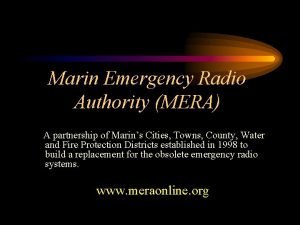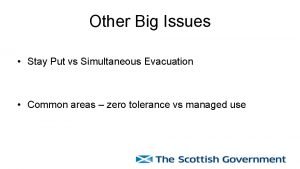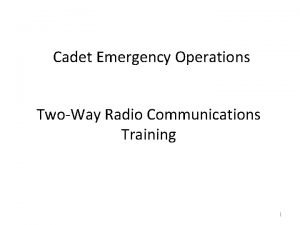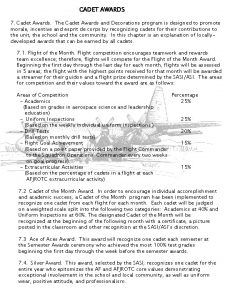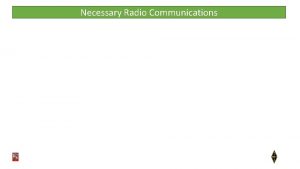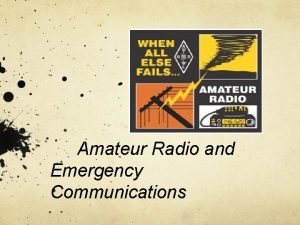Cadet Emergency Operations TwoWay Radio Communications Training 1









- Slides: 9

Cadet Emergency Operations Two-Way Radio Communications Training 1

Universal Rules of Radio Communication (Part 1 of 6): Courtesy of: http: //www. stanag 6001. com/radio-communication-rules/ 1. Before you press the transmission button, gather your thoughts about what you are going to say. Many people with radios have a tendency to talk and/or repeat too much. Say what you need to say without unnecessary repeats. Keep in mind that your message should go through the first time – you may not have any opportunity to repeat it. 2. Give the call sign of the unit you are calling first. It will alert the addressee to focus on the incoming message. There might be more listeners and radio network users so you must let them know that this time there will be a message for them, not a usual background noise. 3. Introduce yourself by your call sign. Do not use real names or nicknames. 4. Don’t speak too fast especially if the message needs to be written down. Pause after logical phrases. High voice does not guarantee that you will be more readable. 5. Use “CLEAR”, “OVER”, “OUT” when you finish your message. It notifies the addressee that you finished your portion of information and wait for the response or just ended the transmission (“OUT” word). 6. When you have understood the message, acknowledge the receipt with the words “COPY“, “RECEIVED“, “ROGER” or “ACKNOWLEDGED. ” The word “COPY” is preferred. 7. If the caller requires some actions you may use “WILCO” instead of “ROGER” to notify that you WILL COMPLY (=”WILCO”). 8. Use “BREAK, BREAK” whenever there is a radio traffic and you want to get through with your emergency message. 9. Answer each call to confirm reception. Use “RECEIVED”, “COPY”, “ROMEO” or “ACKNOWLEDGED. ” 10. If you do not comprehend the message, do not confirm it. Use “SAY AGAIN”, “REPEAT”, “STAND BY” instead. 11. Whenever a word must be spelled use NATO code words for each letter. Do not invent your own words – they might be misleading and not comprehensive. 12. Use single, cardinal numbers, do not combine them into bigger numbers. 2

Universal Rules of Radio Communication (Part 2 of 6): Courtesy of: http: //www. stanag 6001. com/radio-communication-rules/ Call out When you want to initiate radio exchange, first you must call out the addressee of your message. To notify the addressee about incoming message call him/her twice, giving his/her call sign: • Example: “COMMAND, COMMAND…” Then give your call sign: • Example: “THIS IS GRID, OVER. ” When you expect the other party to answer, finish your portion of message with a word “OVER”, like in the example above. If there is a traffic on the air, use “BREAK, BREAK” to cut into the network. Only in case of higher priority of your message! 3

Universal Rules of Radio Communication (Part 3 of 6): Courtesy of: http: //www. stanag 6001. com/radio-communication-rules/ Quality of transmission In case of some interference or just to confirm how your message was received you may need to ask about the reception. In this instance we use “HOW DO YOU COPY? ” or even shorter “HOW COPY? ” To ask about general quality of the reception you may also ask “HOW DO YOU READ? ” There are two ways of responding to such questions. You may simply answer “COPY LOUD AND CLEAR” (=”LIMA CHARLIE”) or give the answerer the notion of the signal quality by giving the note from 1 to 5. • Example: “COPY 3 BY 5” • The meaning of numbers used in assessment over the radio: 1 = Bad (unreadable); 2 = Poor (readable now and then); 3 = Fair (readable but with difficulty); 4 = Good (readable); 5 = Excellent (perfectly readable). 4

Universal Rules of Radio Communication (Part 4 of 6): Courtesy of: http: //www. stanag 6001. com/radio-communication-rules/ When repeat is needed It may happen that due to poor transmission or distracting factors some pieces of information should be repeated to avoid misunderstandings. In that case you may request repeat by saying “SAY AGAIN. ” Likewise, when you want to stress the importance of the message or simply make sure that important data get through, you say your message and then use “I SAY AGAIN” and repeat the message. • EXAMPLE: “I need five more minutes, I SAY AGAIN, five more minutes…” 5

Universal Rules of Radio Communication (Part 5 of 6): Courtesy of: http: //www. stanag 6001. com/radio-communication-rules/ NATO code words for English letters (Phonetic Alphabet) A Alpha N November B Bravo O Oscar C Charlie P Papa D Delta Q Quebec E Echo R Romeo F Foxtrot S Sierra G Golf T Tango H Hotel U Uniform I India V Victor J Juliet W Whiskey K Kilo X X-ray L Lima Y Yankee M Mike Z Zulu N November 6

Universal Rules of Radio Communication (Part 6 of 6): Courtesy of: http: //www. stanag 6001. com/radio-communication-rules/ Numbers in radio transmission It is a common practice to say numbers with each digit separately. For instance we say: “CHARLIE TWO-THREE” instead of “CHARLIE TWENTY THREE. ” Additionally, to avoid misunderstandings two particular numerals are pronounced differently: 4 = “FOER” 9 = “NINER” 7

Two-Way Radio Calls: When communicating on a two-way radios, always remember that when you are transmitting, no one else can. Therefore keep your radio communication short and concise. Here are some procedures and guidelines to follow: To make a call, start by using the call sign of the person you are calling followed by your call sign: • “COMMAND, THIS IS GRID. OVER. ” (You are basically saying: Hey you, this is me. Now it is your turn to answer) To respond to a call, use the same format but let them know you are ready to receive: • “GRID, THIS IS COMMAND. GO AHEAD. OVER. ” (What you are telling them is: Hey you, this is me. I am ready to hear you. Now it is your turn to respond. ) To perform a radio check, use the same call format but add the radio check immediately: • “COMMAND, THIS IS GRID, WITH A RADIO CHECK. OVER. ” (Hey you this is me. Can you hear me? Done for now-your turn. ) To respond to a radio check, use the same initial call format: • “GRID, THIS IS COMMAND. HEAR YOU LOUD AND CLEAR. HOW ME? OVER. ” or, • “GRID, THIS IS COMMAND. HAVE YOU LIMA CHARLIE. HOW ME? OVER. ” or, • “GRID, THIS IS COMMAND. HAVE YOU 4 BY 5. HOW ME? OVER. ” (Hey you, this is me. I can hear you. Can you hear me? Done for now-your turn. ) To complete the radio check, use same initial call format: • “COMMAND, THIS IS GRID. HAVE YOU LOUD AND CLEAR. OVER AND OUT. ” or, • “COMMAND, THIS IS GRID. HAVE YOU LIMA CHARLIE. OVER AND OUT. ” or, • “COMMAND, THIS IS GRID. HAVE YOU 5 BY 5. OVER AND OUT. ” (Hey you, this is me. I can hear you as well. I am done and we are done with this conversation. ) 8

Questions? 9

